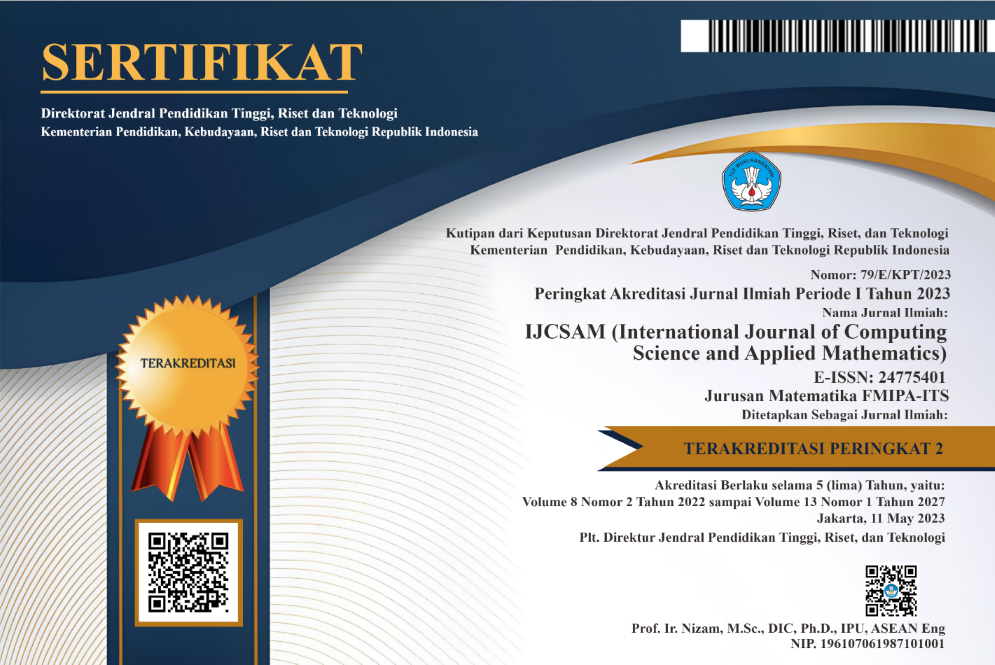Design of Monkeypox Virus Spread Control in Humans Using Pontryagin Minimum Principle
Abstract
Monkeypox is a contagious disease caused by a virus. In Africa, monkeypox results in death in 1 out of 10 infected individuals. The Food and Drug Administration in the United States recommends vaccination as a preventive measure against monkeypox virus. If infected, the World Health Organization (WHO) advises quarantine to prevent further transmission to others. This research develops a mathematical model known as SIR (Susceptible-Infected-Recovered) for the spread of monkeypox virus, incorporating vaccination and quarantine as control measures. The SIR model utilized is based on an existing model and follows the conditions of monkeypox spread in Nigeria, represented as a system of nonlinear differential equations. Optimal control is determined using the Pontryagin Minimum Principle and simulated using the fourth-order forward-backward sweep Runge-Kutta method to assess the level of monkeypox infection before and after implementing control measures. Based on the simulation results, it is concluded that the application of control measures can reduce the population of infected monkeys by 70% and infected humans by 59%.
Full Text:
PDFReferences
L. Kemenkes, “Penyakit cacar monyet (monkeypox) dan yang perlu kita tahu tentangnya,” 2022.
A. Nugroho, “Waspadai meningkatnya kasus cacar monyet,” Universitas Gajah Mada, 2022.
R. Susi Agustianingsih and R. Rina Reorita, “Kontrol optimal pada model SIR dengan pengaruh vaksinasi, karantina, dan faktor imigrasi,” Jurnal Matematika, Statistika, dan Komputasi, vol. 16, no. 3, pp. 311-324, 2020.
H. Fitri Monika Sari and Yundari, “Penyelesaian numerik persamaan diferensial linear homogen dengan koefisien konstan menggunakan metode adams bashforth moulton,” Buletin Ilmiah Mat. Stat. dan Terapannya (Bimaster), vol. 3, no. 2, pp. 125-134, 2014.
C.P. Bhunu and M. S., “Modelling the transmission dynamics of poxlike infections,” IAENG International Journal of Applied Mathematics, vol. 2, no. 41, 2011.
P.E.M. Fine, Z. Jezek, “The transmission potential of monkeypox virus in human populations,” International Journal of Epidemiology, vol. 17, pp. 643-650, 2020.
T. Mardlijah, T.D. Ariani, and T. Asfihani, “Isolation Strategy of a Two-Strain Avian Influenza Model using Optimal Control,” 2021.
D. Anggraeni, Dafik, and S. Setiawani, “The effectiveness of rungekutta method of order nine to solve the immunity model for infection of mycobacterium tuberculosis,” vol. 4, no. 2, pp. 75-88, 2013.
S. Side, G.P. Astari, and M.I. Pratama, “Numerical Solution of Diabetes Mellitus Model without Genetic Factors with Treatment using Runge Kutta Method,” J. Phys. Conf. Ser., 2019.
P. Driessche and J. Watmough, “Reproduction Numbers and Sub-Threshold Endemic Equilibria for Compartmental Models of Disease Transmission,” Mathematical Biosciences, vol. 180, pp. 29-48, 2002.
DOI: http://dx.doi.org/10.12962%2Fj24775401.v10i2.21950
Refbacks
- There are currently no refbacks.
View My Stats

International Journal of Computing Science and Applied Mathematics by Pusat Publikasi Ilmiah LPPM, Institut Teknologi Sepuluh Nopember is licensed under a Creative Commons Attribution-ShareAlike 4.0 International License.
Based on a work at https://iptek.its.ac.id/index.php/ijcsam.






